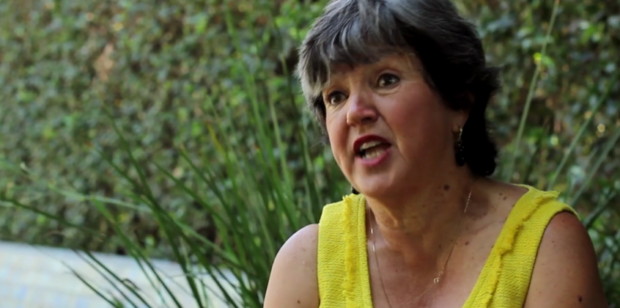The ‘browning’ of California’s Green movement

Belinda Faustinos head sthe nonprofit Nature for All, which helped spearhead efforts that led to the designation of the San Gabriel Mountains in Los Angeles as a national monument in 2014.
Almost 30 years ago East Los Angeles resident and mother of nine kids, Juana Gutierrez took on an oil giant and won. Hailed at the time in national and international media, Gutierrez was seen as being in the vanguard of a “fledgling”environmental movement, one deeply rooted in California’s expanding communities of color.
Today that fledgling movement has blossomed into what is fast becoming the new mainstream of environmental activism in the state.
“Things have obviously changed, not just in the last couple of years but over a number of years,” says Bruce Saito, head of the California Conservation Corps. A veteran of the state’s environmental community, he says that, thanks to the legacy of Gutierrez (who died in 2004) and other activists, today more than ever environmental leaders in California are placing a greater emphasis on the needs of people and communities, particularly in underserved regions.
Voters of color in California have long been among the most ardent supporters of environmental legislation. Pollafter pollshows that pro-environmental sentiment among communities of color in the state exceeds that of whites. And yet the prevailing narrative of environmental activism has continued to remain a largely white affair, with people of color most often relegated to supporting roles.
One recent articlewent so far as to blame the “overwhelming whiteness” of America’s mainstream environmentalism for failing to connect with communities of color, thereby jeopardizing national efforts to tackle the effects of climate change, particularly in the midst of the Trump presidency.
Changing narrative
But Saito and other advocates working in the field say that in California, at least, that narrative is beginning to change.
“For the last 100 years, [environmental] policies in California have been driven by a set of stakeholders…advancing environmental issues for the environment’s sake,” says Alfredo Gonzalez, campaign director for Prop. 68, an environmental bond measure passed by voters in California on June 5. “Today’s leadership is shifting the narrative to be as much about people as it is about nature.”
Gonzalez says Prop. 68 is a good example. Co-authored by Sen. Kevin de Leon (D-Los Angeles) and Assemblymember Eduardo Garcia (D-Coachella), Prop. 68 will generate $4.1 billion for enhancements to California’s water infrastructure, as well as to state and local parks.

California voters approved Prop. 68 on June 5, 2018.
But more to the point, says Gonzalez, the measure specifically directs up to 40 percent of funds to disadvantaged communities confronting some of the state’s worst economic and environmental challenges. (These include the more than 1-million California residents exposed to contaminated water, as well as seven California cities named among the top ten most polluted cities nationally — cities in Southern California and across the Central Valley where a majority of residents are low-income people of color.)
‘Night and day’
It’s “night and day,” says Gonzalez, comparing the language of Prop. 68 to past legislation where vulnerable communities remained peripheral, if they were mentioned at all.
A large portion of Prop. 68 funds — $725 million — will go toward expanding access to green space in park-poor areas of the state, defined as communities with less than three acres of usable parkland per 100,000 residents. Studieshave shown that increased access to green space can have a beneficial impact on residents’ health and on the health of the local watershed, mitigating threats like toxic air and water, and reducing the potential for flooding.
Beyond these benefits, supporters of Prop. 68 say that connecting residents to nature in areas where such connections remain limited can help to engender a new generation of climate activists.
Urban-rural Interface
That’s a key point for Belinda Faustinos, head of the nonprofit Nature for All. Faustinos helped spearhead efforts that led to the designation of the San Gabriel Mountains in Los Angeles as a national monument in 2014. (It was one of a number of designations by the previous administration that President Trump threatened to revoke in 2017.)
Faustinos says the new direction in California’s environmental policy opens up opportunities to bring needed conservation resources to communities in urban areas that were overlooked in the past.
“I can remember very distinctly when I first took my job…meeting with someone at [the state Resources Agency], and the exact quote was, ‘Well, we know we have to send some money down to Southern California, but we know it’s a wasteland.’”
It’s an attitude Faustinos says she continues to encounter among advocates and policymakers who see Los Angeles as being virtually devoid of nature.
But she says efforts in communities like South Los Angeles, where Faustinos pushed for funding a project that created greenspace in the middle of a major roadway, can help build constituencies around broader conservation issues once local needs are addressed.
“It’s a really different perspective, understanding and valuing how important it is to some of these urban communities,” says Faustinos. “We have to value that just as much.”
Damon Nagami, director of the Natural Resources Defense Council’s Southern California Ecosystems Project, agrees. “If we’re trying to get the next generation of environmentalists committed to protecting nature, then we need to meet them where they are,” he says.
Bedrock laws
Nagami notes that, in the early years of the movement, organizations like his focused on “creating bedrock environmental laws. Those were all things that were needed at the formative stages of the movement.” “But,” he adds, “today, we are seeing more of a focus on communities and the impacts on communities.”
It’s a dramatic shift from the original vision of larger, mainstream environmental organizations — the “big greens” — that for years dominated policy decisions in California, and that more often than not tended to put the needs of nature first.
Michelle Passero is a senior policy advisor with The Nature Conservancy, one of the largest conservation nonprofits in California and worldwide. She says the shift toward communities is something she and her colleagues have focused on.
“It’s definitely an active area of conversation and thinking for us,” she says. “We’re certainly engaged in conversations about where investments should be, and being supportive of targeting investments in disadvantaged communities.”
She points to several projects as examples, including work along the Los Angeles Riverand in Merced County, where she is working with a team that includes local environmental justice groups to develop tools that could assist in mitigating what is some of the worst air quality in the country.
“To me it’s part of an evolution,” Passero notes. “How can we embrace a broader scope of environmental issues and concerns that affect all communities?”
Still, the question remains: What does this evolution mean for the future of conservation efforts in the state?
Gonzalez, the Prop. 68 campaign director, warns that with the shift in priorities, leaders in Sacramento may be less inclined to support legislation solely focused on habitat or species protection, particularly as climate change worsens conditions for residents in underserved regions.
‘No appetite for the old way’
“There’s not a lot of appetite for doing things the old way,” he says, “and that could be a problem for the mainstream groups.”
Saito echoes Passero, noting the big conservancies and funders are “very aware of this evolution, and they are trying to do their best” to adjust to the new reality. But he also stresses that challenges remain, including the need to continue to engage over the long term with diverse communities.
He points to the example of Vernon, in East Los Angeles, where Juana Gutierrez fought and eventually won her battle 30 years ago. Today the city is home to one of California’s largest environmental cleanups, an on-again off-again effort to remove lead contaminationleft behind by an Exide Technologies battery recycling plant.
A lawsuit over the cleanup effort is currently pending.
“You’ve got to include folks and get them to buy in for the long-term, not just for a campaign,” says Saito. “Exide is back in Vernon, and that reminds us the struggle is not over.”
This story was produced as part of UCLA’s Laboratory for Environmental Narrative Strategies (LENS) 2018 Watershed Fellowship for Ethnic Media.







